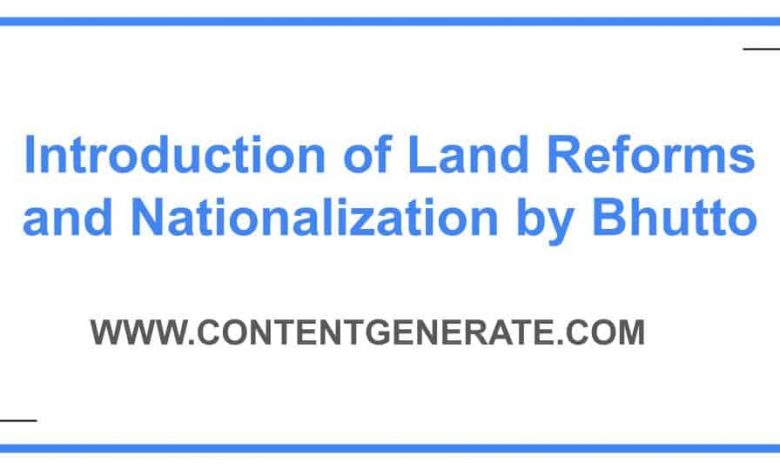Reforms of Zulfiqar Ali Bhutto – Nationalization and Land Reforms
Socialist Reforms in Pakistan

Zulfiqar Ali Bhutto ruled Pakistan as Prime Minister from 1972 -1977. During five years of his rule, Bhutto introduced nationalization and land reforms in Pakistan. This article discusses Bhutto’s reforms, their purpose, and their impact on the economy of Pakistan.
Contents
The concept ‘Nationalization’
Nationalization refers to bring private sector companies under governmental control.
The purpose behind Nationalization
The purpose behind nationalization was to;
- put an end to the inequalities caused by the accumulation of wealth into few hands as only 22 families controlled 80% of Pakistan’s large-scale industries.
- enhance the living standard of the workers and provide a safe environment a the workplace.
- give workers the right to form their unions at the workplace.
- to enhance the acceptance and popularity of the Pakistan Peoples Party (PPP) as prop people and pro workers.
Institutions Nationalized by Bhutto
The institutions that Bhutto nationalized included industries, banks, educational institutions, and insurance companies. The nationalized industries included sugar, cotton, vegetable oil, rice, etc. There were in total 70 major industrial units in the country in different parts of the country. Bhutto charged the Federal Ministry of Production with the responsibility of regulation of these industrial units.
Impact of Bhutto’s nationalization
- Before the nationalization, the inflation rate in Pakistan was 10%. After nationalization, it saw a sharp decrease in the inflation rate which fell to 6% in 1976 which was more than 10% previously.
- At that time world faced the worst sort of economic depression. Private companies were closing due to the decreasing demand for industrial goods in world markets. But, in Pakistan industrial units continued operating with an increase in economic growth.
- As far as the nationalization of education was concerned, there was a decline in the quality of education primarily because of an increasing number of students and untrained staff.
Land reforms
The concept of land reforms
The term land reforms refer to change in the laws with regard to landholding and its various other aspects.
Land reforms introduced by Bhutto
Bhutto introduced land reforms according to which:
- a person could hold a maximum of 250 acres of irrigated and 500 acres of un-irrigated land.
- the surplus land would be taken over by the government and sold to the smaller peasant farmers.
- Tenants would have the first right to purchase of land they farm.
- security of tenants would be provided. The landowner would sign an agreement with the tenant and would not evict the tenants from their land before the expiry of the defined time period.
Impact of the land reforms
Land reforms would have changed the fate of the common people and Pakistan. Similarly, the country would be no longer a feudal state. The security of tenure would have been ensured as tenants could not be evicted by the landlord and they would have a chance to have their own land.
Manipulation by landlords
The government found it difficult to implement the land reforms as envisioned. Landlords had made all alternative arrangements to dodge government. They had transferred their lands in the name of tenants they trusted, relatives, family members, etc. When Bhutto’s rule ended they leased their lands back on long term-leases. Feudal lords were also successful in influencing officials to overlook the implementation of land reforms through bribery and the use of power.
As far as security of the tenure was concerned, it was difficult for a tenant to face the landlord if the latter was not willing to sell his land. Landlords influenced the revenue officials to record land as ‘owner-farmed’ which in reality was cultivated by the tenant.





I love reading your site.
Please check the statement below …its rather 150 ace irrigated & 300 unirrigated in phase I & in phase II it was 100 irrigated & 200 unirrigated
Bhutto introduced land reforms according to which:
a person could hold a maximum of 250 acres of irrigated and 500 acres of un-irrigated land.